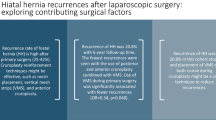Abstract
Background
The aim of this study is to identify factors that can predict hiatal hernia recurrence (HHR) in patients after anti-reflux surgery with hiatal hernia (HH) repair.
Methods
A single-institution, prospectively collected database was reviewed (January 2002–October 2015) with inclusion criteria of GERD and laparoscopic anti-reflux (AR) surgery with HH repair. Demographics, esophageal symptom scores, and pre- and post-upper gastrointestinal imaging (UGI) were collected. Mesh usage, HH type (sliding, paraesophageal (HH) or type IV), and size were evaluated, and patients who had HHR versus those who did not (NHHR) were compared. Statistical analysis was performed using IBM SPSS v.23.0.0, with α = 0.05.
Results
Three hundred twenty-two patients met inclusion criteria. Mean age was 56.9 ± 14.8 years (60.9% female), and mean follow-up was 19.9 ± 23.8 months. 88.2% underwent total fundoplication and 11.8% underwent partial fundoplication. HHR rate was 15.5%. HHR patients had larger HH than the NHHR group. There was no significant difference between groups for age, gender, BMI, race, and mesh usage. Only 3 patients (10.3%) with HHR reported mild-to-moderate heartburn, regurgitation, and solid or liquid dysphagia at 12-month follow-up. Overall reoperation rate was 1% in this population.
Conclusions
HHR is correlated with large hernia size. Mesh use and patient BMI were not predictors, and no correlation was identified between HHR and presence of GERD symptoms. Recurrence after repair is not uncommon, but is asymptomatic in most cases. Reoperation is rare and mesh is not routinely needed. Large asymptomatic HHs in the elderly often do not require intervention.
Similar content being viewed by others
References
Greub G, Liaudet L, Wiesel P, Bettschart V, Schaller M. Respiratory complications of gastroesophageal reflux associated with paraesophageal hiatal hernia. J Clin Gastroenterol. 2003;2:129–131.
Naoum C, Falk G, Yiannikas J. Exercise-induced left atrial compression by a hiatus hernia. J Am Coll Cardiol. 2011;58(14):e27.
Siegal SR, Dolan JP, Hunter JG. Modern diagnosis and treatment of hiatal hernias. Langenbeck’s Archives of Surgery. 2017;402(8):1145–1151.
Koch OO, Schurr M, Antoniou SA, et al. Predictability of hiatal hernia/defect size: Is there a correlation between pre- and intraoperative findings?, Hernia. 2014;18:883–888.
Kubasiak J, Hood KC, Daly S, et al. Improved patient outcomes in paraesophageal hernia repair using a laparoscopic approach: A study of the national surgical quality improvement program data. The American Surgeon. 2014;80(9):884–889.
Jones R, Simorov A, Lomelin D, Tadaki C, Oleynikov D. Long-term outcomes of radiologic recurrence after paraesophageal hernia repair with mesh. Surg Endosc. 2014.
Oor JE, Roks DJ, Koetje JH, Broeders JA, Van Westreenen HL, Nieuwenhuijs VB. Randomized clinical trial comparing laparoscopic hiatal hernia repair using sutures versus sutures reinforced with non-absorbable mesh. Surgical Endoscopy. 2018.
Simorov A, Ranade A, Jones R, et al. Long-term patient outcomes after laparoscopic anti-reflux procedures. J Gastrointest Surg. 2014;18(1):157–62; discussion 162-3.
Eubanks TR, Omelanczuk P, Hillel A, Maronian N, Pope CE, Pellegrini CA. Pharyngeal pH measurements in patients with respiratory symptoms before and during proton pump inhibitor therapy. Am J Surg. 2001;181(5):466–470.
Patti MG, Pellegrini CA, Arcerito M, Tong J, Mulvihill SJ, Way LW. Comparison of medical and minimally invasive surgical therapy for primary esophageal motility disorders. Archives of Surgery. 1995;130(6):609–616.
Lomelin D, Smith A, Bills N, et al. Long-term effectiveness of Strattice in the laparoscopic closure of paraesophageal hernias. Surg Innov. 2017;24(3):259–263.
Grubnik VV, Malynovskyy AV. Laparoscopic repair of hiatal hernias: New classification supported by long-term results. Surg Endosc. 2013;27(11):4337–4346.
Hashemi M, Peters JH, DeMeester TR, et al. Laparoscopic repair of large type III hiatal hernia: Objective followup reveals high recurrence rate. J Am Coll Surg. 2000;190(5):553–60; discussion 560-1.
Antiporda M, Veenstra B, Jackson C, Kandel P, Daniel Smith C, Bowers SP. Laparoscopic repair of giant paraesophageal hernia: Are there factors associated with anatomic recurrence?, Surg Endosc. 2018;32(2):945–954.
Lidor AO, Kawaji Q, Stem M, et al. Defining recurrence after paraesophageal hernia repair: Correlating symptoms and radiographic findings. Surgery. 2013;154(2):171–178.
El Lakis MA, Kaplan SJ, Hubka M, Mohiuddin K, Low DE. The importance of age on short-term outcomes associated with repair of giant paraesophageal hernias. Ann Thorac Surg. 2017;103(6):1700–1709.
Dallemagne B, Quero G, Lapergola A, Guerriero L, Fiorillo C, Perretta S. Treatment of giant paraesophageal hernia: Pro laparoscopic approach. Hernia. 2017.
Chang CG, Thackeray L. Laparoscopic hiatal hernia repair in 221 patients: Outcomes and experience. JSLS. 2016;20(1):https://doi.org/10.4293/JSLS.2015.00104.
Oelschlager BK, Pellegrini CA, Hunter J, et al. Biologic prosthesis reduces recurrence after laparoscopic paraesophageal hernia repair: A multicenter, prospective, randomized trial. Ann Surg. 2006;244(4):481–490.
Funding
Funding for this study was provided by the Center for Advanced Surgical Technology at the University of Nebraska Medical Center.
Author information
Authors and Affiliations
Contributions
The contribution of each author, as defined by the ICMJE guidelines, is as follows: PRA: data acquisition, analysis, and interpretation; drafting and revision; final approval; accuracy and integrity; BP: data acquisition, analysis, and interpretation; revision; final approval; accuracy and integrity; MM: data acquisition, analysis, and interpretation; revision; final approval; accuracy and integrity; SP: data acquisition, analysis, and interpretation; drafting; final approval; accuracy and integrity; DO: design of work, data acquisition, analysis, and interpretation; revision; final approval; accuracy and integrity.
Corresponding author
Ethics declarations
Approval for this study was obtained from our Institutional Review Board.
Additional information
Publisher’s Note
Springer Nature remains neutral with regard to jurisdictional claims in published maps and institutional affiliations.
Information in this paper was presented as a poster at the 2017 Digestive Disease Week, May 6–9, Chicago, IL, USA.
Rights and permissions
About this article
Cite this article
Armijo, P.R., Pokala, B., Misfeldt, M. et al. Predictors of Hiatal Hernia Recurrence After Laparoscopic Anti-reflux Surgery with Hiatal Hernia Repair: a Prospective Database Analysis. J Gastrointest Surg 23, 696–701 (2019). https://doi.org/10.1007/s11605-018-04073-0
Received:
Accepted:
Published:
Issue Date:
DOI: https://doi.org/10.1007/s11605-018-04073-0




